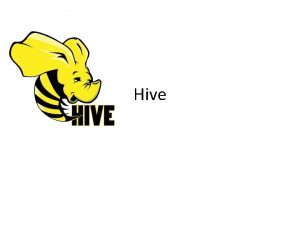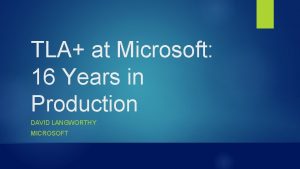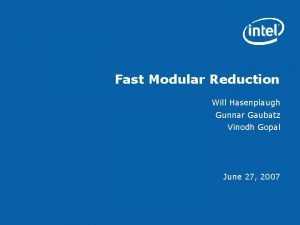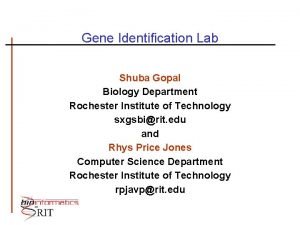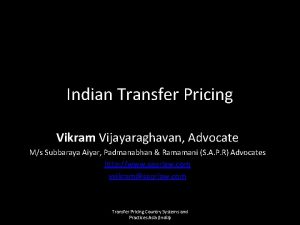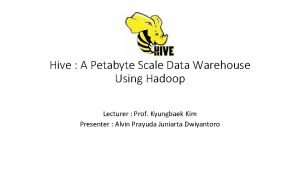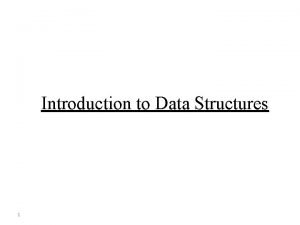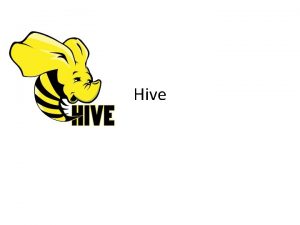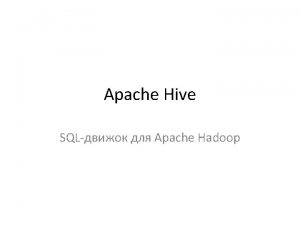Hive Data Organization for Performance Gopal Vijayaraghavan Page













- Slides: 13

Hive: Data Organization for Performance Gopal Vijayaraghavan Page 1 © Hortonworks Inc. 2011 – 2016. All Rights Reserved

In this episode Data navigation? All Big. Data problems are primarily lookup problems All Lookup problems are really Storage problems All Storage problems turn into ETL problems Data organization? Data ingestion? ETL problems are all about the Data It’s Big? Page 2 © Hortonworks Inc. 2011 – 2016. All Rights Reserved

Good idea: Do things that scale! There are many problems like this, but this one is mine Page 3 © Hortonworks Inc. 2011 – 2016. All Rights Reserved

Partitions If you have a database on cars and you partition on VIN# If you have a database on sales and you partition on customer_id Rule of thumb: Average partition is >=1 Gb and total # of partitions per query <1000 Page 4 © Hortonworks Inc. 2011 – 2016. All Rights Reserved

Buckets If you have more files than rows, you’ve definitely got bucketing wrong “clustered by” != “cluster by” Bucketing on a skewed column slows down ETL a *lot* (for no win) If you have partitions, sort-merge bucket-mapjoin can be slower than a shuffle!! Page 5 © Hortonworks Inc. 2011 – 2016. All Rights Reserved

Buckets - II Histograms! select explode(histogram_numeric( hash(<col>)% <n-bucket>, <n-bucket> )) as h from table; The Curse of 31 & the last byte If you have buckets & partitions, always remember to ETL with set hive. optimize. sort. dynamic. partition=true; Page 6 © Hortonworks Inc. 2011 – 2016. All Rights Reserved

Denormalization can turn a compute problem into an IO/lookup problem. But if you then optimize that with compression, you get a compute problem again. If you think JOINs are bad, you probably haven’t moved out of Map. Reduce. Broadcast joins are good & dynamically partitioned broadcast joins can scale that ~1000 x Page 7 © Hortonworks Inc. 2011 – 2016. All Rights Reserved

Indexes? Indexes in hive barely help in a columnar world – incremental rebuild isn’t really there ORC maintains internal bloom filter indexes (PARQUET-41 too) You can store your indexes as ORC files, if you want, so that you can have an index in your index, to speedup indexes Page 8 © Hortonworks Inc. 2011 – 2016. All Rights Reserved

Schema & Predicate Push Down Never store a Number as a string, because guess what “ 11” < “ 9” and “ 11. 0” != “ 11” – transform, then load Predicate push-down cannot fight the type system (♫ … breaking blocks in the hot sun ♫) UDFs applied on the data column is always a bad idea for fast filtering. If you need case-insensitive lookups, always store as UPPER/lower. If you need LIKE “%. twimg. com”, store like DNS does “. com. twimg…” Page 9 © Hortonworks Inc. 2011 – 2016. All Rights Reserved

Temporary tables In-memory temp-tables set hive. exec. temporary. table. storage=memory; Easiest way to reorganize data temporarily or to produce a “distinct slice” “create temporary table if not exists stored as orc as select …” Can be used for pagination queries to good effect, for display tools Page 10 © Hortonworks Inc. 2011 – 2016. All Rights Reserved

Complex types & Nesting There’s pretty much no advantage to using structs – they’re nearly columns, without any of the good stuff Maps – not so bad, but handle with care Maps are way better than 4000 columns, most of them null Arrays – ignore mostly (JDBC!!) Page 11 © Hortonworks Inc. 2011 – 2016. All Rights Reserved

Schema Evolution Add columns, never remove them Schemas are per-partition Remember, the partitions don’t change their schema after they’re created All new inserts have new schema After schema update, inserting data into old partitions is a recipe for disaster Type changes for a column also complicate things (except for simple stuff like Int -> Big. Int or Float -> Double) Page 12 © Hortonworks Inc. 2011 – 2016. All Rights Reserved

Questions? ? Page 13 © Hortonworks Inc. 2011 – 2016. All Rights Reserved

